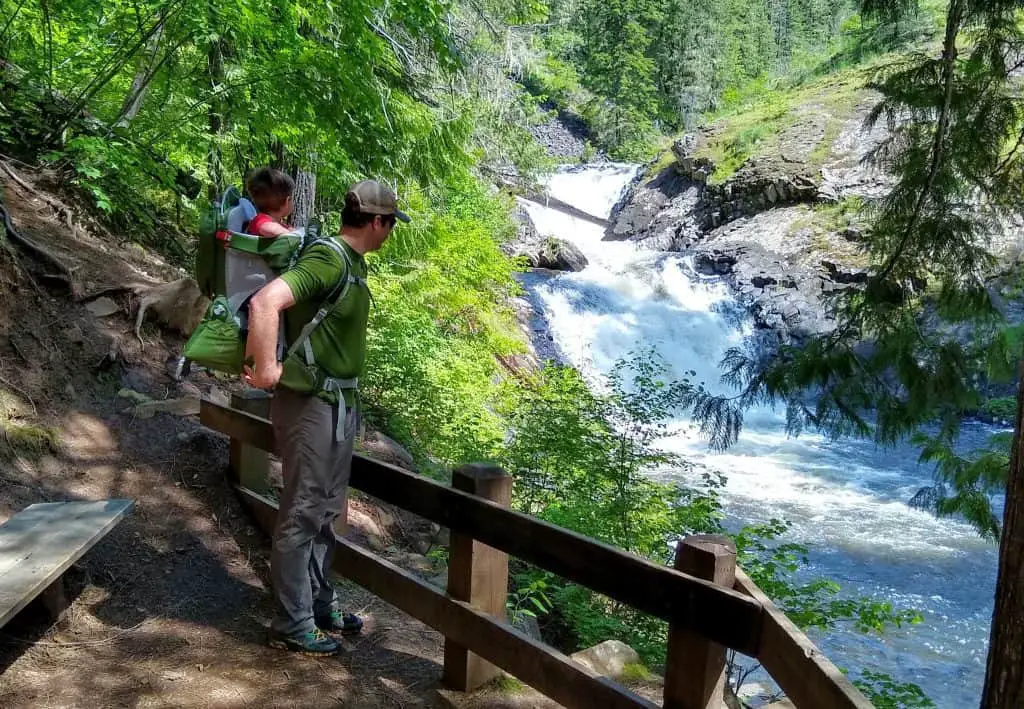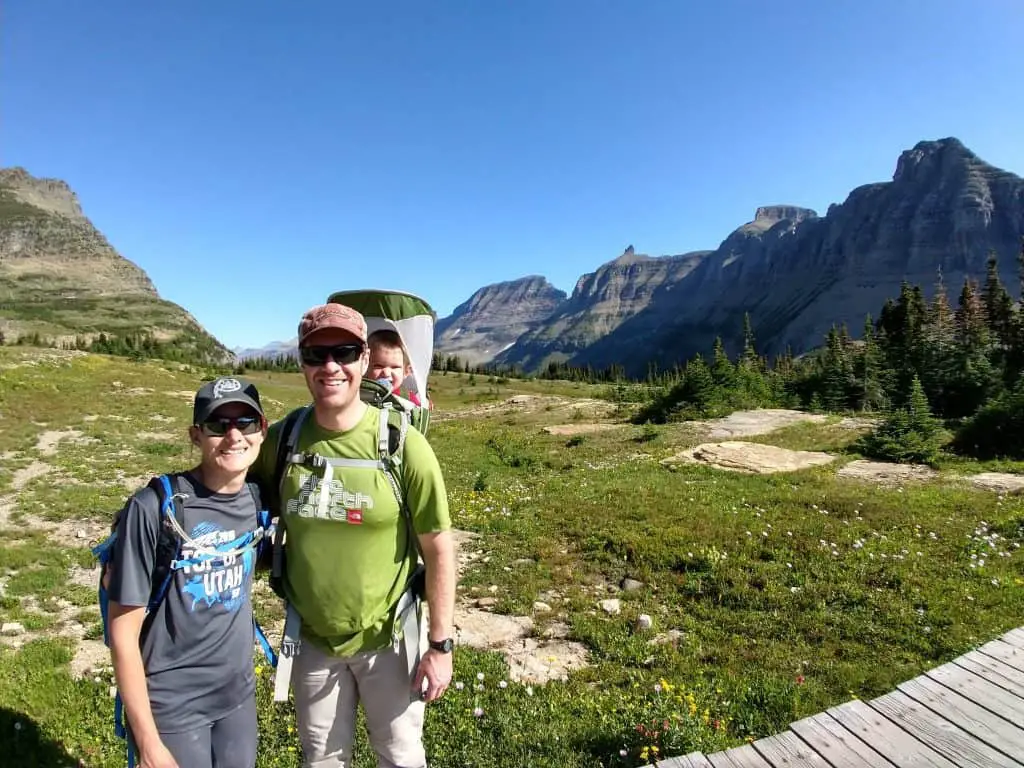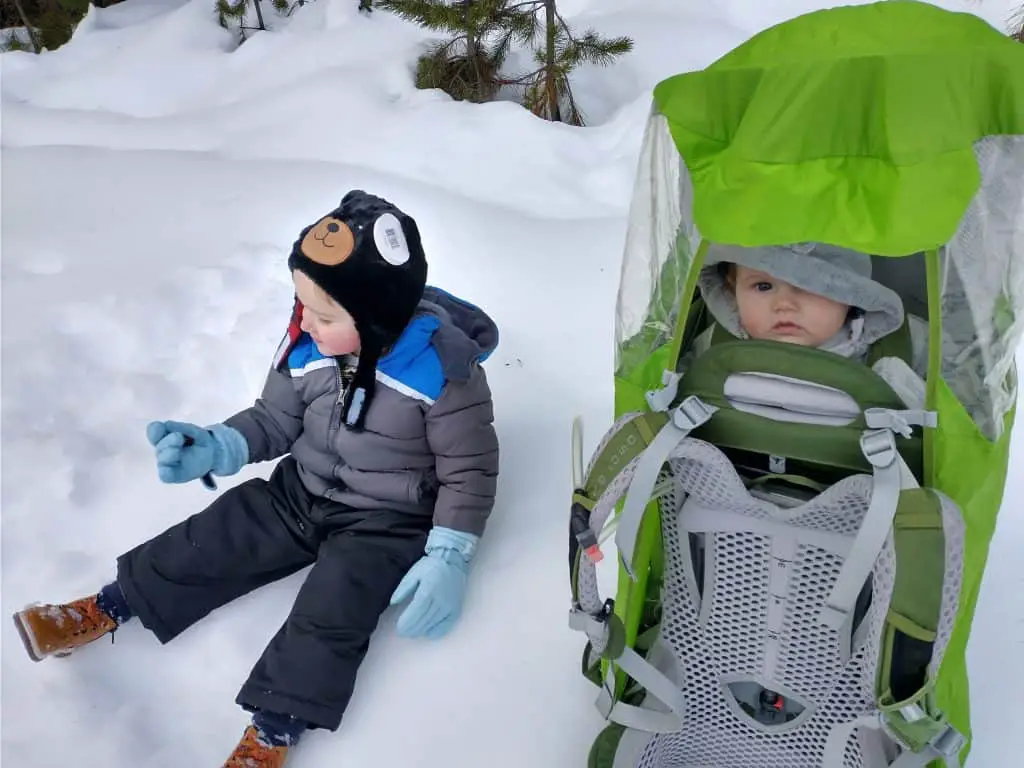How well does the Osprey Poco (Plus) child carrier backpack work for hiking with babies and toddlers? That was the question on our (my wife’s and I) minds when we decided to spend a big chunk of change (about $275) from our meager, graduate-student budget to get the backpack. Three years later (and still in graduate school) we don’t regret it and I don’t think our kids do either.
The most important part of teaching kids to love the outdoors is getting them to have fun outdoors. With kids having fun outside is easy. Generally, all you have to do is get them outside and they have a blast exploring and seeing new things. The Osprey Poco helps our family get outside more and go more places than we would without it.
Overview
The Osprey Poco Plus is a great backpack that can carry children up to 40 lbs. It is as comfortable as you can expect when carrying a toddler and provides enough gear storage to support a day-long outing.
There are some slight annoyances with the Osprey Poco. Namely, it’s difficult to pair with a hydration reservoir and the large storage compartment isn’t very functional.
Fit and Comfort
The Osprey Poco has adjustable shoulder straps and hip belt to fit a wide range of body sizes. I’m 6′ 1″ and need the pack at the tallest setting to fit me most comfortably. My wife is about 5′ 7″ and the Poco fits her best between the medium and small height settings (extra small is the smallest setting).
My wife has a narrow waist and the padding length on the hip straps is about right for her. I’m a little bulkier (~200 lbs.) and find the padding on the straps to be a little short.
We both wish the padded area of the hip belt was wider. When you’re carrying a 20-pound kid plus water, diapers, snacks, etc. you need a good hip belt to hold and stabilize the load.
Similarly, it would be nice to add a little padding, width, and/or stiffness to the shoulder straps. The shoulder straps are adequate but leave something to be desired. There’s not quite as beefy as the straps you find on backpacking packs.
If you load the Poco to its full weight capacity (40 lbs) it definitely pushes comfort limits. It’s still adequately comfortable but I really start to feel it after 3 to 4 miles. Still, the Poco is a much better method than anything else we’ve used to carry our kids on hikes.
We’ve done several hikes of 5 plus miles with a kid in the Osprey Poco and it’s been pretty comfortable for everyone. My wife even filled the Poco to max capacity and carried our son 7 miles, one-way, on an overnight backpacking trip.
The bottom line is that the Osprey Poco could be improved but overall it is a sturdy, capable, and useful pack.
Features and Specs
I’m not going to spend a lot of time regurgitating what you can get more concisely from Osprey’s website. So here’s the link. I will tell you some of the features of the Osprey Poco that we do and don’t like.
Extra Storage Space
The extra storage space is the main reason we upgraded from the Poco to the Poco Plus. We wanted enough storage to hold enough gear for a full day out and potentially do an overnighter.
Space in the detachable backpack is quite functional, it has one big pocket and is convenient for many items. The collapsible, lower compartment isn’t as easy to use. As more items are added to the lower compartment it is no longer collapsible and does not distribute weight well.
Also, when the sunshade is down, it takes up space in the lower compartment and there is not at much storage volume as advertised. Still, between my wife (carrying the Poco and our son) and me (carrying my Baltoro 75 stuffed to the gills) we had enough capacity to do an overnight backpack with our two-year-old.
I would say the storage is functional, but not always the most comfortable.

Sunshade
The sunshade on the Osprey Poco is a great feature. It protects kids from the sun, obviously, but there is much more it can do. I almost always pull the sunshade up because it gives the passenger something to rest their head on when they sleep and limits the bouncing. It also makes it really easy to use a rain cover to keep the kid and gear dry.

Rain Cover
The Osprey Poco doesn’t come with a rain cover but I would recommend getting one. To be honest I’ve only used the rain cover in the rain one time but I have used it in many other situations.
We found that the rain cover does a really good job of blocking wind and trapping heat. When the wind is bothering the kid in the backpack just put the rain cover on and they’re comfortable. Is it a cold day? Throw on the rain cover and it helps trap their (and your) body heat so they stay warmer.

Hydration Reservoir Compartment
Osprey says that the reservoir pouch/compartment on the Poco will accommodate any Osprey hydration reservoir. This is not a true statement. I have a couple of different 3-liter reservoirs. Once made by Osprey and one made by Camelbak. Neither one fits in the Poco’s compartment.
I bought a 2-liter reservoir from Ultimate Direction because it’s compatible with my running pack. The UD reservoir does fit in the Poco’s compartment. Just barely.
If you plan on using a hydration reservoir with the Poco it’s a good idea to test it out before you buy, just to make sure it works.
Conclusion
The Osprey Poco isn’t a perfect backpack. It’s not always comfortable, especially as kids get older and heavier. And it can be hard to fit all the gear you want for extended trips, even with the large-volume model.
Still, it’s been a great backpack for us. The most important thing is that it allows us to get outside with our kids so they can experience the joys the outdoors have to offer. From my research, it seems like the best model out there and even though it was a big purchase I have not regretted it and am glad I have it.
